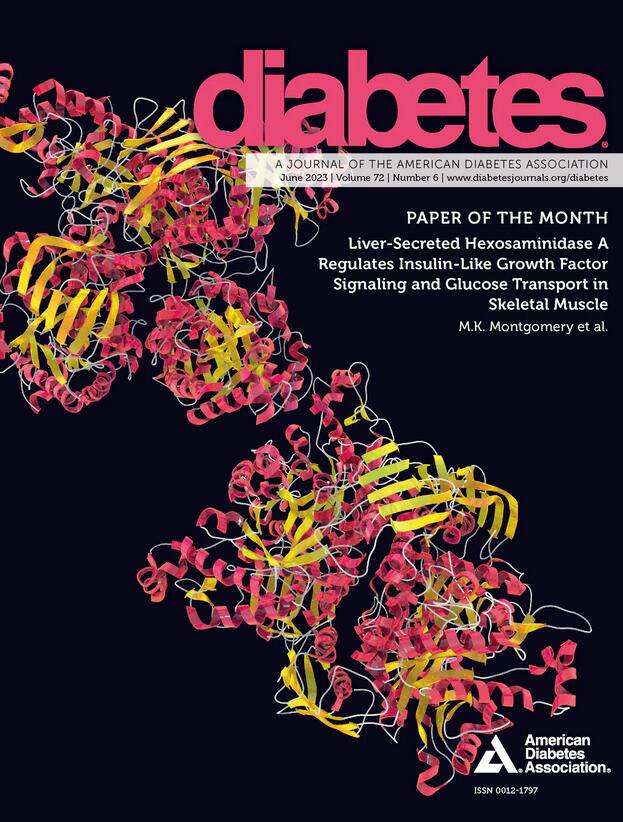232-OR: Accuracy of Real-Time Continuous Glucose Monitoring in Hospitalized Patients with Diabetes and Impaired Kidney Function
IF 7.5
1区 医学
Q1 ENDOCRINOLOGY & METABOLISM
引用次数: 0
Abstract
Introduction and Objective: Continuous glucose monitoring (CGM) systems improve glycemic control in patients with type 1 diabetes (T1D) and type 2 diabetes (T2D) by reducing hypoglycemia and increasing time within target glucose range compared to capillary blood glucose testing. Recent factory-calibrated real-time CGM systems have enhanced usability and accuracy. However, their performance in patients with impaired kidney function, especially those in the hospital where high accuracy is crucial, has not been investigated. This study aimed to evaluate the accuracy of real-time CGM in hospitalized patients with diabetes and impaired kidney function. Methods: A total of 24 patients with diabetes, including T1D (n = 2), T2D (n = 20), and pancreatic diabetes (n = 2), hospitalized in a general ward were enrolled. Participants were categorized into three groups based on estimated glomerular filtration rate (eGFR, mL/min/1.73m²): G1-2 (eGFR ≥60), G3 (eGFR 30-59), and G4-5 (eGFR <30). Capillary glucose values measured using a point of care device (Accu-Chek Guide One, Roche) were compared with the glucose readings from a real-time CGM (G6, Dexcom) recorded at the closest corresponding time. Accuracy was assessed using mean absolute relative difference (MARD), the percentage of readings within ±15% or ±15 mg/dL of reference values (%15/15), and %20/20. Results: The study analyzed 289, 325, and 155 glucose pairs from the G1-2 (n=9), G3 (n=9), and G4-5 (n=6) groups, respectively. Mean HbA1c levels were 9.4% in G1-2, 11.2% in G3, and 7.2% in G4-5, with significant intergroup differences (p = 0.004). The overall MARD was 13.5%, with group-specific values of 15.9% in G1-2, 12.7% in G3, and 10.1% in G4-5, with significant differences among groups (p < 0.001). The intergroup difference was consistent with %15/15 (p < 0.001) and %20/20 (p < 0.001). Conclusion: This study demonstrated the accuracy of real-time CGM in hospitalized patients with diabetes and impaired kidney function. Disclosure Y. Kakutani: None. T. Morioka: Research Support; Boehringer-Ingelheim. S. Miyamoto: None. Y. Yamazaki: None. A. Ochi: None. K. Mori: Research Support; Mitsubishi Tanabe Pharma Corporation, Kyowa Kirin Co., Ltd, Sumitomo Dainippon Pharma Co., Ltd. Speaker's Bureau; Mitsubishi Tanabe Pharma Corporation, AstraZeneca, Novo Nordisk, Boehringer-Ingelheim, Kyowa Kirin Co., Ltd, Eli Lilly and Company. T. Shoji: None. M. Emoto: Speaker's Bureau; Novo Nordisk, Kyowa Kirin Co., Ltd. Research Support; Boehringer-Ingelheim.232-OR:糖尿病合并肾功能受损住院患者实时连续血糖监测的准确性
简介和目的:与毛细血管血糖测试相比,连续血糖监测(CGM)系统通过减少低血糖和延长血糖在目标范围内的时间来改善1型糖尿病(T1D)和2型糖尿病(T2D)患者的血糖控制。最近工厂校准的实时CGM系统增强了可用性和准确性。然而,它们在肾功能受损患者中的表现,特别是在那些对准确性至关重要的医院中,尚未得到调查。本研究旨在评估实时CGM在糖尿病合并肾功能受损住院患者中的准确性。方法:选取24例在普通病房住院的糖尿病患者,包括T1D (n = 2)、T2D (n = 20)和胰腺糖尿病(n = 2)。参与者根据估计的肾小球滤过率(eGFR, mL/min/1.73m²)分为三组:G1-2 (eGFR≥60),G3 (eGFR 30-59)和G4-5 (eGFR & lt;30)。使用点护理设备(Accu-Chek Guide One, Roche)测量的毛细血管葡萄糖值与在最近相应时间记录的实时CGM (G6, Dexcom)的葡萄糖读数进行比较。使用平均绝对相对差(MARD)、参考值±15%或±15mg /dL范围内的读数百分比(%15/15)和%20/20来评估准确性。结果:本研究分别分析了G1-2 (n=9)、G3 (n=9)和G4-5 (n=6)组289、325和155对葡萄糖。G1-2组平均HbA1c水平为9.4%,G3组为11.2%,G3组为7.2%,组间差异有统计学意义(p = 0.004)。总体MARD为13.5%,G1-2组为15.9%,G3组为12.7%,G3组为10.1%,组间差异有统计学意义(p <;0.001)。组间差异符合%15/15 (p <;0.001)和%20/20 (p <;0.001)。结论:本研究证实了实时CGM在糖尿病合并肾功能损害住院患者中的准确性。角谷y:没有。T. Morioka:研究支持;勃林格殷格翰集团。宫本茂:没有。山崎:没有。A. Ochi:没有。K. Mori:研究支持;三菱田边制药株式会社、协和麒麟株式会社、住友大日制药株式会社演讲者的局;三菱田边制药公司、阿斯利康、诺和诺德、勃林格殷格翰、协和麒麟有限公司、礼来公司。Shoji:没有。江本先生:发言人局;诺和诺德协和麒麟股份有限公司研究支持;勃林格殷格翰集团。
本文章由计算机程序翻译,如有差异,请以英文原文为准。
求助全文
约1分钟内获得全文
求助全文
来源期刊

Diabetes
医学-内分泌学与代谢
CiteScore
12.50
自引率
2.60%
发文量
1968
审稿时长
1 months
期刊介绍:
Diabetes is a scientific journal that publishes original research exploring the physiological and pathophysiological aspects of diabetes mellitus. We encourage submissions of manuscripts pertaining to laboratory, animal, or human research, covering a wide range of topics. Our primary focus is on investigative reports investigating various aspects such as the development and progression of diabetes, along with its associated complications. We also welcome studies delving into normal and pathological pancreatic islet function and intermediary metabolism, as well as exploring the mechanisms of drug and hormone action from a pharmacological perspective. Additionally, we encourage submissions that delve into the biochemical and molecular aspects of both normal and abnormal biological processes.
However, it is important to note that we do not publish studies relating to diabetes education or the application of accepted therapeutic and diagnostic approaches to patients with diabetes mellitus. Our aim is to provide a platform for research that contributes to advancing our understanding of the underlying mechanisms and processes of diabetes.
 求助内容:
求助内容: 应助结果提醒方式:
应助结果提醒方式:


